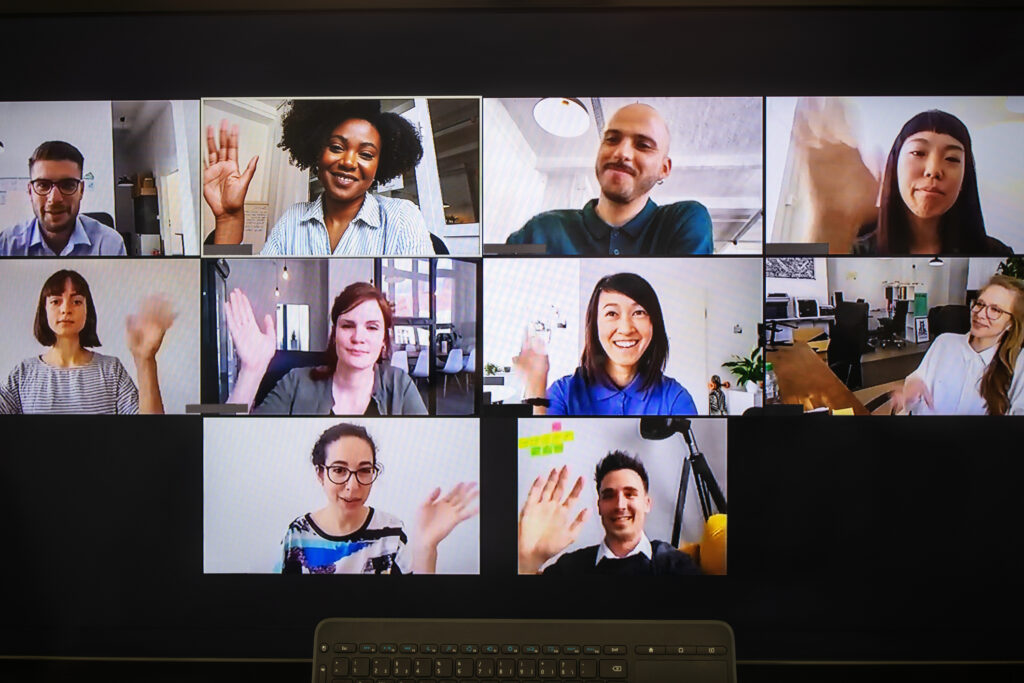Even for the most charismatic speakers, adjusting to a virtual setting can be a bit awkward. Unlike in-person presentations, you don’t have the benefit of establishing a presence in the room. With mics muted and cameras turned off, you don’t get the same in-the-moment feedback that you do in person, which can be unnerving if you’re not used to it.
But the biggest challenge in presenting online may be figuring out how to engage your audience in an online presentation. An InterCall study found that over 60% of people are doing other work or checking email while on a conference call. Others admitted to making and eating food, checking their phones, and even exercising.
These days, you’re more likely to give a presentation online than in person, so it’s a great time to brush up on your presentation skills and adjust them for a virtual setting. Keep reading for our tips on engaging your online audiences and getting people’s attention online.

Keep your camera on
There are few things as interesting to humans as other human faces. In fact, a study by Richard Franz demonstrated that infants will stare twice as long at faces than at shapes. If you want people to pay attention to you when you present online, make sure they can see your face.
Virtual presentations often include screen shares and visual aids that block the speaker from view. With the video presentation maker Prezi Video, you can put all the content of your presentation next to you on screen, so you can keep that face-to-face connection with your online audience, even when you refer to something visually.
Prezi Video has helped people continue delivering effective presentations even as things shifted to more remote settings. Moving to Prezi Video was a “complete game-changer” for Belinda Keeble, Managing Director and Co-Founder of Secondnature International. “We could deliver truly effective training online by using an online platform that enabled us to be side by side with our slides”:
Set the scene
Even though you’re not in the same space as the people you’re speaking with, that doesn’t mean they need to be reminded of it. Make sure the background of your video is clean and that there aren’t any distracting pieces, like dirty dishes, bedsheets, or clothes. A bookshelf or houseplants would do.
Make eye contact
The best speakers get people’s attention online by scanning the room and making eye contact with the people in their audience, but you don’t have this luxury when you’re presenting online. Instead, look into the camera when you’re speaking, so your online audience can feel as though you’re speaking to them. Your camera should be at about eye-level to make it feel natural and easy.

Make sure you’re not too close or too far away from the camera. In her Presenting on Video series, Jessica Chen of Soulcast Media recommends about 2-3 feet of space between you and the camera. Learn more in her video here:
Keep things moving along
Don’t forget that virtual presentations are more difficult to pay attention to than in-person presentations. A 20-minute presentation can easily feel twice as long when it’s online. Professional speaker Rob Jolles recommends developing a “communication shot clock” and limiting the time you spend on each story to about 45-60 seconds in order to keep things moving.
Less text, more images
Including images in your presentation is a great way to make your presentation stand out and engage your audience in an online presentation. Just by including images, your audience is likely to remember about 65% of the information three days later.
Instead of adding text to your presentation, talk through it. You should keep things moving along, and if you add text, you might want to slow down and let your online audience read it before moving on.
Avoid tech fails
Before your meeting, do a test run to make sure everything on your computer is working smoothly and that you’re comfortable with your audio and camera setup. You want to avoid something failing in the middle of your presentation and having to take an awkward break to get everything up and running again.
If you want to avoid any possibility of an on-the-spot technical fail, record your presentation ahead of time and share it with your online audience. Prezi Video makes it easy to record and save a video of your presentation. Share a link within your network or upload it to cloud platforms like Google Classroom.
Don’t be monotone
Your voice has a lot of power in an online presentation. Since you can’t physically interact with your online audience, your voice does even more work in communicating your feelings and holding your audience’s attention. It’s good to improve your voice technique if you’re delivering a lot of online presentations.

Start by keeping these rules in mind:
- Your tone of voice indicates the emotion you want your audience to feel.
- The volume of your voice can indicate key points of your presentation. Speak louder when you want to reinforce something.
- Mumbling and a flat tone is difficult to pay attention to and far too tempting to tune out. Make sure to speak clearly.
These are some hands-on ways you can improve your voice for presentations, including warmups, breathing exercises, using gestures, recording your voice to understand your strength and weakness, and practicing.
Get comfortable with silence
A lot of people feel anxious when there’s “dead air” or silence in their presentation, but if you’re presenting online, you have to get used to it. Most of your online audience will be on mute, so you can’t hear them react to your presentation (that means no sighs, chuckles, or “ahas”). Get comfortable with the fact that you won’t be able to get this kind of feedback in an online presentation.
On the upside, there’s a lot less background noise during your presentation, giving you more control over the sound and tone of your presentation. As scary as it might be, a well-timed pause can add an element of drama. Use a silent pause to hit a beat after dropping a shocking fact, or to give your online audience a moment to reflect on what you’ve said and come up with questions. If you choose to give a long monologue to avoid silence, you’re actually further discouraging your online audience from engaging.

Add animations to your presentation
Animations help you emphasize important points and make your presentation more dynamic. According to Marielou Mandl, a professional Digital Content and Experiential Event Producer, the presentations that perform best are the ones with moving graphics. Movement attracts your online audience’s attention. You can easily add movement, such as the zoom-in and zoom-out effects, to your presentation using Prezi Present and Prezi Design. Use with caution. Too many animations may distract your online audience from the actual content of your presentation.
Be on time!

People’s days are packed with tons of tasks every day. As a presenter, you should be mindful of people’s schedules. Start your presentation on time and work within the time you’ve scheduled (in other words, don’t go over time). If there are more things to cover, you can send an email to participants after the presentation or arrange a follow-up discussion.
Here are a few ways to keep your presentation on time:
- Know your start and end time
- Watch the clock
- Time each section
- Adapt as you present
- Practice, Practice, Practice
Using interactive elements
Encourage your online audience to engage and interact with you by incorporating it into your presentation, such as leaving time for Q&A, discussion, or having a little friendly competition with a game. When it comes to how to engage shy and quiet audiences in an online presentation, you have to meet them where they’re at. Many people are unwilling to talk for the fear of saying something wrong or ignorant, so in this case, you can use an anonymous poll to gather your online audience’s thoughts. Even your most introverted audience members can engage and contribute that way.

Focus on what really matters
People can’t take in too much information at once, so don’t try to cover everything in one presentation. Instead, focus on one specific subject. If you jump around different topics, people won’t be able to follow along as easily. Just focus on one topic and make sure your online audience understands it and that it sticks in people’s heads. Also, don’t lose track of time. Keep things short, sweet, and to the point..
Ask for feedback
If you want to improve your online presentation skills, ask for feedback. Collecting feedback is a good way for you to understand your strengths and weaknesses in getting people’s attention online. After your presentation, send out surveys to get anonymous feedback and analyze it to discover the highs and lows in your presentation. Make adjustments, and ask for feedback again after your next event. Rinse and repeat – asking for and using feedback is a never-ending process.

Presenting online is never going to be quite like presenting in the room, but by making a few adjustments, you can create an online experience that engages your online audience and gets people’s attention on you. Learn more about how Prezi can help you build an immersive presentation that pops online, or contact us for more on our business solutions.
